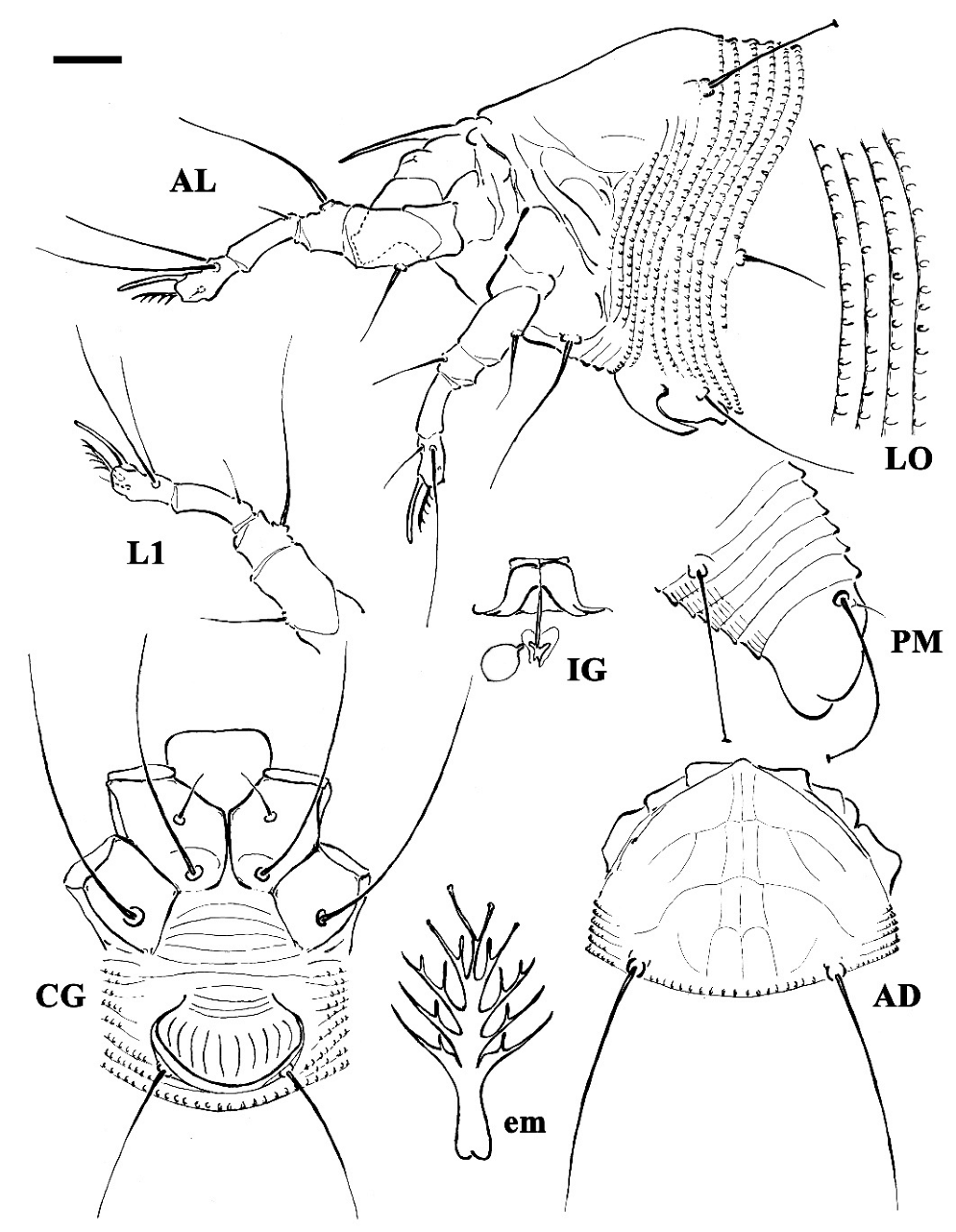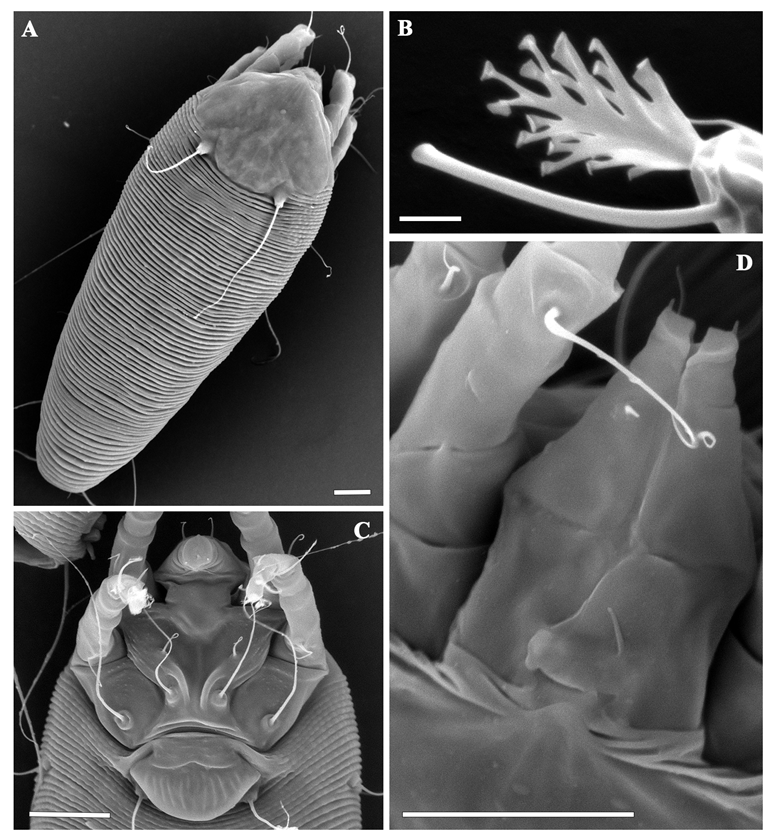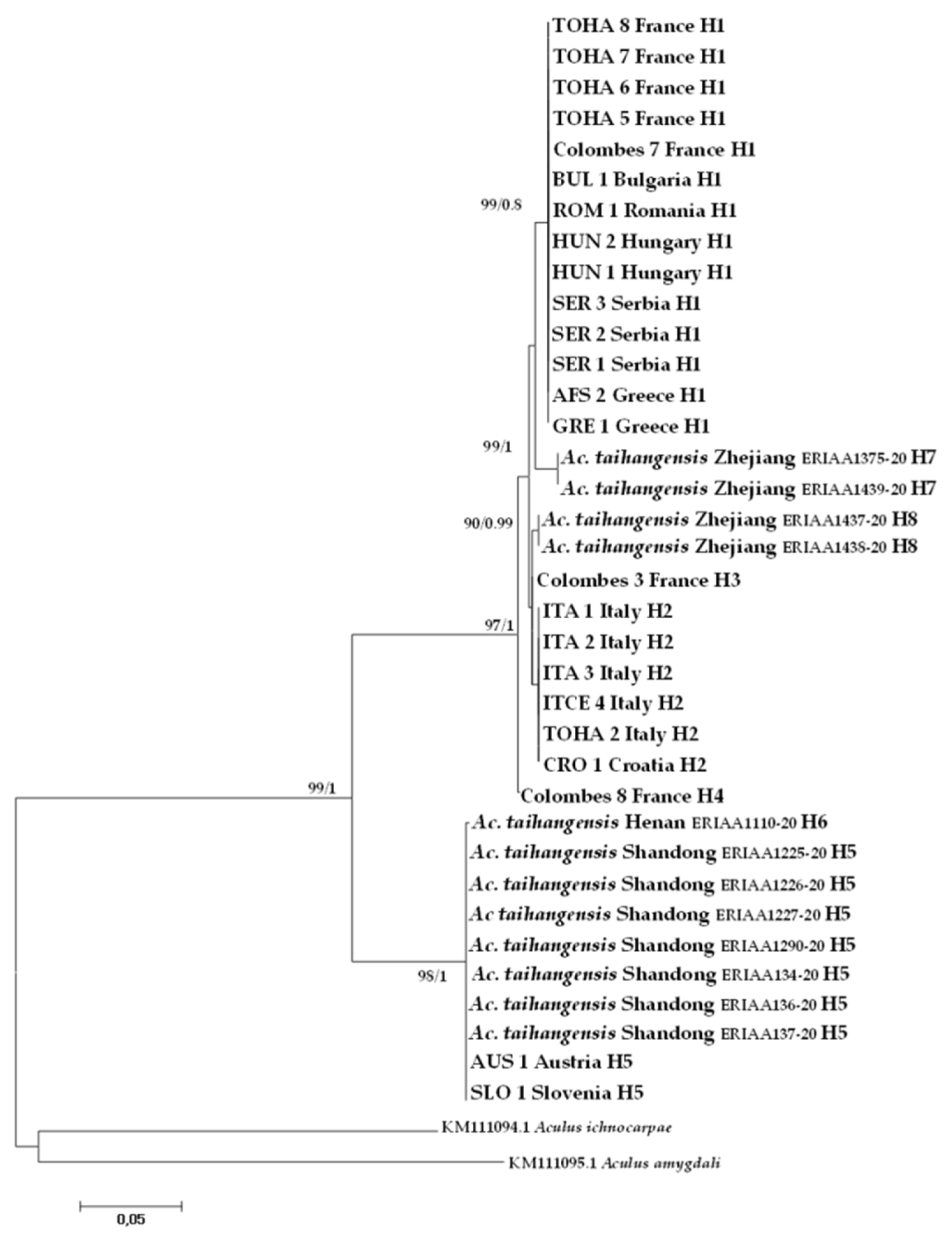Integrative Taxonomy and Synonymization of Aculus mosoniensis (Acari: Eriophyidae), a Potential Biological Control Agent for Tree of Heaven (Ailanthus altissima)
Abstract
:Simple Summary
Abstract
1. Introduction
2. Materials and Methods
2.1. Morphological Study by Light Microscopy
2.2. Morphological Study by Scanning Electron Microscopy
2.3. Sampling for the Molecular Study and DNA Extraction
2.4. Markers for the Molecular Study
2.5. Alignments, Phylogenetic Analyses, and Genetic Distance for the Molecular Study
3. Results
3.1. Morphological Study
3.2. Description
3.3. Molecular and Phylogenetic Analyses
4. Discussion and Conclusions
Author Contributions
Funding
Institutional Review Board Statement
Data Availability Statement
Acknowledgments
Conflicts of Interest
References
- Nooteboom, H.P. Ailanthus. In Flora Malesiana (Ser I, 6); Noordhoff International publishing: Leyden, The Netherlands, 1962; pp. 215–222. [Google Scholar]
- Burch, P.L.; Zedaker, S.M. Removing the Invasive Tree Ailanthus altissima and Restoring Natural Cover. J. Arboricult. 2003, 29, 18–24. [Google Scholar] [CrossRef]
- Heisey, R.M. Identification of an allelopathic compound from Ailanthus altissima (Simaroubaceae) and characterization of its herbicidal activity. Am. J. Bot. 1996, 83, 192–200. [Google Scholar] [CrossRef]
- Kowarik, I.; Säumel, I. Biological flora of Central Europe: Ailanthus altissima (Mill.) Swingle. Per. Pl. Ecol. Evol. Syst. 2007, 8, 207–237. [Google Scholar] [CrossRef]
- Krussmann, G.; Wennemuth, G.; Thon, H.E. Die baumschule, 5th ed.; Parey: Berlin, Germany, 1981; p. 565. [Google Scholar]
- Marini, F.; Profeta, E.; Vidović, B.; Petanović, R.; de Lillo, E.; Weyl, P.; Hinz, H.L.; Moffat, C.E.; Bon, M.C.; Cvrković, T.; et al. Field Assessment of the Host Range of Aculus mosoniensis (Acari: Eriophyidae), a Biological Control Agent of the Tree of Heaven (Ailanthus Altissima). Insects 2021, 12, 637. [Google Scholar] [CrossRef]
- de Lillo, E.; Panzarino, O.; Loverre, P.; Valenzano, D.; Mattia, C.; Marini, F.; Augé, M.; Cristofaro, M. New eriophyoid mites from Italy. IV. Mites associated with weed plants. Syst. Appl. Acarol. 2017, 22, 2256–2272. [Google Scholar] [CrossRef]
- Ripka, G.; Érsek, L. A new Aculops species (Acari: Prostigmata: Eriophyoidea) on Ailanthus altissima from Hungary. Acta Phytopathol. Entomol. Hung. 2014, 49, 49–56. [Google Scholar] [CrossRef]
- Gardener, R.T. Native and Indigenous Biocontrols for Ailanthus Altissima. Master’s Thesis, University of Maryland, College Park, MD, USA, 2008. [Google Scholar]
- Skvarla, M.J.; Ochoa, R.; Ulsamer, A.; Amrine, J. The eriophyid mite Aculops ailanthi Lin, Jin, & Kuang, 1997 (Acariformes: Prostigmata: Eriophyidae) from tree-of-heaven in the United States-new state records and morphological observations. Acarologia 2021, 61, 121–127. [Google Scholar]
- de Lillo, E.; Craemer, C.; Amrine, J.W., Jr.; Nuzzaci, G. Recommended procedures and techniques for morphological studies of Eriophyoidea (Acari: Prostigmata). Exp. Appl. Acarol. 2010, 51, 283–307. [Google Scholar] [CrossRef]
- Dayrat, B. Towards integrative taxonomy. Biol. J. Linn. Soc. 2005, 85, 407–415. [Google Scholar] [CrossRef]
- de Lillo, E.; Vidović, B.; Petanović, R.; Cristofaro, M.; Marini, F.; Augé, M.; Cvrković, T.; Babić, E.; Mattia, C.; Lotfollahi, P.; et al. A new Aculodes species (Prostigmata: Eriophyoidea: Eriophyidae) associated with medusahead, Taeniatherum caput-medusae (L.) Nevski (Poaceae). Syst. Appl. Acarol. 2018, 23, 1217. [Google Scholar] [CrossRef] [Green Version]
- de Lillo, E.; Fanelli, E.; Valenzano, D.; Monfreda, R.; Troccoli, A.; Vovlas, A.; De Luca, F. Characterization of Aceria massalongoi and a histopathology study of the leaf galls induced on chaste tree. Exp. Appl. Acarol. 2020, 82, 33–57. [Google Scholar] [CrossRef]
- Skoracka, A.; Kuczyński, L.; Szydło, W.; Rector, B. The wheat curl mite Aceria tosichella (Acari: Eriophyoidea) is a complex of cryptic lineages with divergent host ranges: Evidence from molecular and plant bioassay data. Biol. J. Linn. Soc. 2013, 109, 165–180. [Google Scholar] [CrossRef] [Green Version]
- Manson, D.C.M.; Oldfield, G. Life forms, deutogyny, diapause and seasonal development. In Eriophyoid Mites Their Biology, Natural Enemies and Control; Lindquist, E.E., Sabelis, M.W., Bruin, J., Eds.; World Crop Pests 6; Elsevier Science Publishers: Amsterdam, The Netherlands, 1996; pp. 173–183. [Google Scholar]
- Valenzano, D.; Tumminello, M.T.; Gualandri, V.; de Lillo, E. Morphological and molecular characterization of the Colomerus vitis erineum strain (Trombidiformes: Eriophyidae) from grapevine erinea and buds. Exp. Appl. Acarol. 2020, 80, 183–201. [Google Scholar] [CrossRef]
- Baker, E.W.; Kono, T.; Amrine, J.W., Jr.; Delfinado-Baker, M.; Stasny, T.A. Eriophyoid mites of the United States; Indira Publishing House: West Bloomfield, MI, USA, 1996. [Google Scholar]
- Keifer, H.H. Eriophyoidea Nalepa. Injurious eriophyoid mites. In Mites Injurious to Economic Plants; Jeppson, L.R., Keifer, H.H., Baker, E.W., Eds.; University California Press: Berkeley, CA, USA, 1975; pp. 327–533. [Google Scholar]
- Lindquist, E.E. External anatomy and notation of structures. In Eriophyoid Mites Their Biology, Natural Enemies and Control; Lindquist, E.E., Sabelis, M.W., Bruin, J., Eds.; World Crop Pests 6; Elsevier Science Publishers: Amsterdam, The Netherlands, 1996; pp. 3–31. [Google Scholar]
- Amrine, J.W., Jr.; Manson, D.C.M. Preparation, mounting and descriptive study of Eriophyoid mites. In Eriophyoid Mites Their Biology, Natural Enemies and Control; Lindquist, E.E., Sabelis, M.W., Bruin, J., Eds.; World Crop Pests 6; Elsevier Science Publishers: Amsterdam, The Netherlands, 1996; pp. 383–396. [Google Scholar]
- Amrine, J.W., Jr.; Stasny, T.A.; Flechtmann, C.H.W. Revised Keys to World Genera of Eriophyoidea (Acari: Prostigmata); Indira Publishing House: West Bloomfield, MI, USA, 2003. [Google Scholar]
- Dabert, J.; Ehrnsberger, R.; Dabert, M. Glaucalges tytonis sp. n. (Analgoidea, Xolalgidae) from the barn owl Tyto alba (Strigiformes, Tytonidae): Compiling morphology with DNA barcode data for taxon descriptions in mites (Acari). Zootaxa 2008, 1719, 41–52. [Google Scholar]
- Kashefi, J.; Vidović, B.; Guermache, F.; Cristofaro, M.; Bon, M.C. Occurrence of Aculus mosoniensis (Ripka 2014) (Acari: Prostigmata: Eriophyoidea) on tree of heaven (Ailanthus altissima Mill.) is expanding across Europe: First records in France confirmed by barcode. Phytoparasitica 2021, 49, 49–51. [Google Scholar] [CrossRef]
- Navajas, M.; Lagnel, J.; Fauvel, G.; De Moraes, G. Sequence variation of ribosomal internal transcribed spacers (ITS) in commercially important phytoseiidae mites. Exp. Appl. Acarol. 1999, 23, 851–859. [Google Scholar] [CrossRef]
- Carew, M.E.; Goodisman, M.A.D.; Hoffmann, A.A. Species status and population genetic structure of grapevine eriophyoid mites. Entomol. Exp. Appl. 2004, 111, 87–96. [Google Scholar] [CrossRef]
- Hall, T.A. BioEdit: A User-Friendly Biological Sequence Alignment Editor and Analysis Program for Windows 95/98/NT. Nucleic Acids Symp. Ser. 1999, 41, 95–98. [Google Scholar]
- Rozas, J.; Ferrer-Mata, A.; Sánchez-DelBarrio, J.C.; Guirao-Rico, S.; Librado, P.; Ramos-Onsins, S.E.; Sánchez-Gracia, A. DnaSP 6: DNA Sequence Polymorphism Analysis of Large Datasets. Mol. Biol. Evol. 2017, 34, 3299–3302. [Google Scholar] [CrossRef]
- Yin, Y.; Yao, L.-F.; Hu, Y.; Shao, Z.-K.; Hong, X.-Y.; Hebert, P.D.N.; Xue, X.-F. DNA barcoding uncovers cryptic diversity in minute herbivorous mites (Acari, Eriophyoidea). Mol. Ecol. Res. 2022, 00, 1–13. [Google Scholar] [CrossRef]
- Tamura, K.; Stecher, G.; Kumar, S. MEGA11: Molecular Evolutionary Genetics Analysis Version 11. Mol. Biol. & Evol. 2021, 38, 3022–3027. [Google Scholar]
- Kimura, M. A simple method for estimating evolutionary rate of base substitutions through comparative studies of nucleotide sequences. J. Mol. Evol. 1980, 16, 111–120. [Google Scholar] [CrossRef]
- Srivathsan, A.; Meier, R. On the inappropriate use of Kimura-2-parameter (K2P) divergences in the DNA-barcoding literature. Cladistics 2012, 28, 190–194. [Google Scholar] [CrossRef]
- Ronquist, F.; Teslenko, M.; Mark, P.; Ayres, D.; Darling, A.; Höhna, S.; Larget, B.; Liu, L.; Suchard, M.; Huelsenbeck, J. MrBayes 3.2: Efficient Bayesian Phylogenetic Inference and Model Choice Across a Large Model Space. Syst. Biol. 2012, 61, 539–542. [Google Scholar] [CrossRef] [Green Version]
- Schwarz, G. Estimating the dimension of a model. Ann. Stat. 1978, 6, 461–464. [Google Scholar] [CrossRef]
- Hasegawa, M.; Kishino, H.; Yano, T. Dating of the human-ape splitting by a molecular clock of mitochondrial DNA. J. Mol. Evol. 1985, 22, 160–174. [Google Scholar] [CrossRef]
- Jukes, T.H.; Cantor, C.R. Evolution of protein molecules. In Mammalian Protein Metabolism; Munro, H.N., Ed.; Academic Press: New York, NY, USA, 1969; pp. 21–132. [Google Scholar]
- Hong, X.-Y.; Xue, X.-F. Four new species of Aculops Keifer (Acari: Eriophyidae) from China. Oriental Ins. 2005, 39, 203–211. [Google Scholar] [CrossRef]
- Duarte, M.E.; De Mendonça, R.S.; Skoracka, A.; Silva, E.S.; Navia, D. Integrative taxonomy of Abacarus mites (Eriophyidae) associated with hybrid sugarcane plants, including description of a new species. Exp. Appl. Acarol. 2019, 78, 373–401. [Google Scholar] [CrossRef]
- Lin, F.P.; Jin, C.; Kuang, H.Y. A new genus and six new species of Eriophyidae from China (Acari: Eriophyoidea). Acta Entomol. Sin. 1997, 40, 86–93. [Google Scholar]






| Country | Locality/Province for China | GPS Coordinates | Collection Date (dd/mm/yyyy) | ID | CO1 GenBank Accession | CO1 Haplotype | ID | ITS1 GenBank Accession | ITS1 Haplotype |
|---|---|---|---|---|---|---|---|---|---|
| Aculops taihangensis | |||||||||
| China | Shandong | 36°15′18″ N 117°00′36″ E and 37°31′37″ N 121°22′01″ E | 21/07/2020 | ERIAA1225–1227; 1290; 134; 136–137 | H5 | ||||
| (Yin et al., 2022) | |||||||||
| Henan | 34°27′46″ N 113°04′26″ E | 15/07/2020 | ERIAA1110 | H6 | |||||
| (Yin et al., 2022) | |||||||||
| Zhejiang | 29°16′37″ N 121°03′14″ E | 30/08/2020 and 20/08/2020 | ERIAA1375; 1439 | H7 | |||||
| and 30°06′39″ N 118°54′03″ E | (Yin et al., 2022) | ||||||||
| Zhejiang | 30°06′39″ N 118°54′03″ E | 20/08/2020 | ERIAA1437–1438 | H8 | |||||
| (Yin et al., 2022) | |||||||||
| Taihang mountain, Hebei province | na | 22/08/2003 | Tube n. 24, Paratype, legit Xue Xiao-Feng | OM948701 | H1 | ||||
| (this study) | |||||||||
| Aculus mosoniensis | |||||||||
| Italy | Saxa Rubra, Rome | 41°58′52″ N 12°29′38″ E | 13/11/2015 | ITA 1 a | OM912723 | H2 | |||
| (this study) | |||||||||
| Castrocielo, Frosinone | 44°29′51″ N 13°41′03″ E | 14/08/2017 | ITA 2 a | OM912724 | H2 | ||||
| (this study) | |||||||||
| Montepulciano, | 43°05′23″ N 11°46′47″ E | 19/08/2017 | ITA 3 a | OM912725 | H2 | ||||
| Siena | (this study) | ||||||||
| Cesano, Rome | 42°03′50″ N 12°19′44″ E | 7/07/2020 | ITCE 4 a | MZ398134 | H2 | ||||
| (Marini et al., 2021) | |||||||||
| TOHA 2 b | MW892618.1 | H2 | TOHA 2 cl1, cl3, cl6 b clones | OM948702-4 | H8 | ||||
| (Kashefi et al., 2021) | (this study) | ||||||||
| TOHA 2 cl5, 12, 15 b clones | OM948705-7 | H9 | |||||||
| (this study) | |||||||||
| Bari | 41°06′38″ N 16°52′55″ E | 31/10/2017 | Ailbud c | OM948708 | H2 | ||||
| (this study) | |||||||||
| Ailleaf c | OM948709 | H2 | |||||||
| (this study) | |||||||||
| Croatia | Karlobag | 44°31′25″ N 15°04′45″ E | 9/08/2017 | CRO 1 a | OM912726 | H2 | |||
| (this study) | |||||||||
| Greece | Thessaloniki | 40°29′49″ N 22°59′19″ E | 12/08/2017 | GRE 1 a | OM912727 | H1 | GRE 1 a | OM948710 | H6 |
| (this study) | (this study) | ||||||||
| 40°34′15″ N 22°59′11″ E | 20/08/2020 | AFS 1 b | OM912728 | H1 | AFS 1.0 b | OM948711 | H5 | ||
| (this study) | (this study) | ||||||||
| AFS 1.1 b | OM948712 | H6 | |||||||
| (this study) | |||||||||
| Serbia | New Belgrade | 44°49′31″ N 20°25′22″ E | 10/05/2017 | SER 1 a | OM912729 | H1 | SER 1 a | OM948713 | H6 |
| (this study) | (this study) | ||||||||
| Zemun | 44°50′33″ N 20°24′19″ E | 27/02/2018 | SER 2 a,* | OM912730 | H1 | ||||
| (this study) | |||||||||
| 45°22′53″ N 20°43ʹ37″ E | 9/09/2018 | SER 3 a | OM912731 | H1 | SER 3 a | OM948714 | H6 | ||
| (this study) | (this study) | ||||||||
| Hungary | Palmonostora | 46°41′36″ N 19°56′07″ E | 2/09/2018 | HUN 1 a | OM912732 | H1 | |||
| (this study) | |||||||||
| Lakitelek | 46°50′49″ N 19°58′43″ E | 6/09/2018 | HUN 2 a | OM912733 | H1 | ||||
| (this study) | |||||||||
| Romania | Timisoara | 45°45′09″ N 21°12′38″ E | 1/09/2018 | ROM 1 a | OM912734 | H1 | ROM 1 a | OM948715 | H6 |
| (this study) | (this study) | ||||||||
| Bulgaria | Nessebar | 42°39′37″ N 27°44′07″ E | 12/08/2020 | BUL 1 b | OM912735 | H1 | BUL 1.0 b | OM948716 | H6 |
| (this study) | (this study) | ||||||||
| BUL 1.1 b | OM948717 | H5 | |||||||
| (this study) | |||||||||
| Austria | Vienna | 48°13′56″ N 16°25′02″ E | 6/07/2017 | AUS 1 a | OM912736 | H5 | AUS 1.0 a | OM948718 (this study) | H3 |
| (this study) | AUS 1.1 a | OM948719 | H4 | ||||||
| (this study) | |||||||||
| Slovenia | Ilirska Bistrica | 45°30′54″ N 14°09′29″ E | 6/08/2017 | SLO 1 a | OM912737 | H5 | SLO 1.0 a | OM948720 | H3 |
| (this study) | (this study) | ||||||||
| SLO 1.1 a | OM948721 | H4 | |||||||
| (this study) | |||||||||
| France | Colombes | 48°55′23″ N 2°13′57″ E | 26/05/2020 | Colombes3 b | MW892615 | H3 | Colombes cl7 b clones | OM948722 | H6 |
| (Kashefi et al., 2021) | (this study) | ||||||||
| Colombes cl8, cl12, cl14, cl15 b clones | OM948723-6 | H7 | |||||||
| (this study) | |||||||||
| Colombes cl11 b clones | OM948727 | H8 | |||||||
| (this study) | |||||||||
| Colombes7 b | MW892616 | H1 | |||||||
| (Kashefi et al., 2021) | |||||||||
| Colombes8 b | MW892617 | H4 | |||||||
| (Kashefi et al., 2021) | |||||||||
| Viols le Fort | 43°44′45″ N 3°42′31″ E | 4/08/2020 | TOHA 5 b | MW892619 | H1 | TOHA 5 b | OM948728 | H6 | |
| (Kashefi et al., 2021) | (this study) | ||||||||
| Manosque | 43°48′31″ N 5°48′47″ E | 9/09/2020 | TOHA 6 b | MW892620 | H1 | TOHA 6 b | OM948729 | H6 | |
| (Kashefi et al., 2021) | (this study) | ||||||||
| Vinon sur Verdon | 43°43′50″ N 5°48′43″ E | 10/09/2020 | TOHA 7 b | MW892621 | H1 | TOHA 7 b | OM948730 | H6 | |
| (Kashefi et al., 2021) | (this study) | ||||||||
| Sisteron | 44°10′15″ N 5°56′55″ E | 10/09/2020 | TOHA 8 b | MW892622 | H1 | TOHA 8 b | OM948731 | H6 | |
| (Kashefi et al., 2021) | (this study) | ||||||||
| Aculops taihangensis n = 12 | Aculus mosoniensis n = 24 | Aculus ichnocarpae n = 1 | Aculus amygdali n = 1 | |
|---|---|---|---|---|
| Aculops taihangensis n = 12 | p: 5.62 ± 0.59 K2P: 6.23 ± 0.74 | 7.68 ± 0.76 | 22.55 ± 1.52 | 24.25 ± 1.51 |
| Aculus mosoniensis n = 24 | 8.49 ± 0.99 | p: 2.38 ± 0.28 K2P: 2.59 ± 0.32 | 23.03 ± 1.59 | 24.78 ± 1.61 |
| Aculus ichnocarpae n = 1 | 27.06 ± 2.22 | 27.80 ± 2.32 | 24.62 ± 1.63 | |
| Aculus amygdali n = 1 | 29.74 ± 2.41 | 30.57 ± 2.57 | 30.37 ± 2.68 |
| Aculops taihangensis n = 1 | Aculus mosoniensis n = 44 | Aculus cercidis n = 1 | |
|---|---|---|---|
| Aculops taihangensis n = 1 | 2.26 ± 0.52 | 37.02 ± 2.38 | |
| Aculus mosoniensis n = 44 | 2.31 ± 0.54 | p: 2.26 ± 0.48 K2P: 2.32 ± 0.42 | 37.10 ± 2.44 |
| Aculus cercidis n = 1 | 51.53 ± 4.7 | 51.65 ± 4.68 |
Publisher’s Note: MDPI stays neutral with regard to jurisdictional claims in published maps and institutional affiliations. |
© 2022 by the authors. Licensee MDPI, Basel, Switzerland. This article is an open access article distributed under the terms and conditions of the Creative Commons Attribution (CC BY) license (https://creativecommons.org/licenses/by/4.0/).
Share and Cite
de Lillo, E.; Marini, F.; Cristofaro, M.; Valenzano, D.; Petanović, R.; Vidović, B.; Cvrković, T.; Bon, M.-C. Integrative Taxonomy and Synonymization of Aculus mosoniensis (Acari: Eriophyidae), a Potential Biological Control Agent for Tree of Heaven (Ailanthus altissima). Insects 2022, 13, 489. https://doi.org/10.3390/insects13050489
de Lillo E, Marini F, Cristofaro M, Valenzano D, Petanović R, Vidović B, Cvrković T, Bon M-C. Integrative Taxonomy and Synonymization of Aculus mosoniensis (Acari: Eriophyidae), a Potential Biological Control Agent for Tree of Heaven (Ailanthus altissima). Insects. 2022; 13(5):489. https://doi.org/10.3390/insects13050489
Chicago/Turabian Stylede Lillo, Enrico, Francesca Marini, Massimo Cristofaro, Domenico Valenzano, Radmila Petanović, Biljana Vidović, Tatjana Cvrković, and Marie-Claude Bon. 2022. "Integrative Taxonomy and Synonymization of Aculus mosoniensis (Acari: Eriophyidae), a Potential Biological Control Agent for Tree of Heaven (Ailanthus altissima)" Insects 13, no. 5: 489. https://doi.org/10.3390/insects13050489
APA Stylede Lillo, E., Marini, F., Cristofaro, M., Valenzano, D., Petanović, R., Vidović, B., Cvrković, T., & Bon, M.-C. (2022). Integrative Taxonomy and Synonymization of Aculus mosoniensis (Acari: Eriophyidae), a Potential Biological Control Agent for Tree of Heaven (Ailanthus altissima). Insects, 13(5), 489. https://doi.org/10.3390/insects13050489









